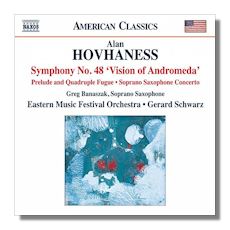
The Internet's Premier Classical Music Source
Related Links
- Hovhaness Reviews
- Latest Reviews
- More Reviews
-
By Composer
-
Collections
DVD & Blu-ray
Books
Concert Reviews
Articles/Interviews
Software
Audio
Search Amazon
Recommended Links
Site News
 CD Review
CD Review
Alan Hovhaness

- Prelude & Quadruple Fugue, Op. 128
- Concerto for Soprano Saxophone & Strings, Op. 344 *
- Symphony #48 "Vision of Andromeda", Op. 355
* Greg Banaszak, soprano saxophone
Eastern Music Festival Orchestra/Gerard Schwarz
Naxos American Classics 8.559755
Gerard Schwarz is probably the greatest living advocate of Alan Hovhaness, and possibly the greatest ever. Early in his career, he championed the composer on Delos in Seattle, later transitioning flawlessly to Naxos with various ensembles. More than any other musician, Schwarz has remained loyal to the composer despite Hovhaness' steadfastly conservative musical style and somewhat grandiose titles that the music rarely lives up to. Everything on this disc is completely captivating in terms of tonal beauty, and lovers of American music will doubtless welcome another of the composer's 67 symphonies to the recorded catalog.
While the serious and very lovely Prelude and Quadruple Fugue of 1954 shows off the early musical talent in full bloom at age 25, I have to chuckle at the box, which calls this one of his "most exciting works". If that's the case, then the rest of his output deserves its reputation as relentlessly pretty but equally static. Yes, the music moves more purposefully than most of his later works, and there are some moments of radiance and tension, but nothing is particularly thrilling, at least until the very end. You have to admire the mastery of form and confidence on display – in itself a thrill – and the Eastern Music Festival Orchestra plays very well. They are a group of staff and professionals that work together for only five weeks each year, but no apologies need to be made. They play cohesively and intelligently. It helps to have Schwarz, who in addition to his commitment to the composer, has a long history of working with diverse and often hodgepodge ensembles.
The strings of this ensemble play alone alongside saxophonist Greg Banaszak. Hovhaness always wrote well for solo instruments, and this subdued and somewhat bluesy creation will tickle the ear of anyone interested in what the saxophone can do as a solo instrument. I imagine that saxophone students will be intrigued, but perhaps less than enamored; the work doesn't do much that could be considered innovative or exciting. For causal listeners, Hovhaness stays in the middle of the register for such a high-pitched instrument, and does all he can to minimize aural fatigue. At just under 20 minutes, the length and content strikes me as nearly ideal, while Banaszak knows exactly what his job is and does it exceptionally. Schwarz recognizes that the strings are basically ambiance to the singing of his wind soloist, and stays out of the way. That's not to say he doesn't get his ensemble to play with character, but nor does he try to make his accompaniment anything that it isn't supposed to be. This is a gorgeous piece, even if the middle of the second movement sounds an awful lot like "Bipitty Boppity Boo".
In the Symphony #48, the distinctively "mystical" qualities of the composer's music are here in full force. This is its first recording, a symphony "Inspired by the wonders and mysteries of astronomy". It certainly evokes a sense of spaciousness and awe, though how "celestial" the work is remains entirely up to you. There are some nice percussion effects and the whole piece is masterfully played considering that these players so rarely see each other. Hovhaness as here is deceptively difficult, with his repeated rhythms and demands on the strings and winds especially. Schwarz does exactly what he should with this music and simply has a good time. I imagine that listeners will as well. An undemanding program on the listener, but a rewarding one all the same.
Copyright © 2015, Brian Wigman





















